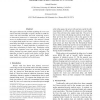Free Online Productivity Tools
i2Speak
i2Symbol
i2OCR
iTex2Img
iWeb2Print
iWeb2Shot
i2Type
iPdf2Split
iPdf2Merge
i2Bopomofo
i2Arabic
i2Style
i2Image
i2PDF
iLatex2Rtf
Sci2ools
INFOCOM
1993
IEEE
1993
IEEE
Queueing Delays in Rate Controlled ATM Networks
This paper addresses the problem of finding the worst case end-to-end delay and buffer occupancy bounds in ATM networks with rate-controlled, non-work conserving servers. A theoretical framework is constructed to analyze such servers in isolation and in tandem. The analysis is based on a simple fluid model, but care is taken so that the computed delay and buffer occupancy values are upper bounds on actual values. A simple algorithm is presented to perform these calculations in linear time. Simulation results compare the computed worst case delays with the actual delays obtained on some simple network topologies. The algorithm is found to predict node delays well for bursty input traffic, but poorly for smooth input traffic. Buffer requirements are predicted well in both cases.
| Added | 08 Aug 2010 |
| Updated | 08 Aug 2010 |
| Type | Conference |
| Year | 1993 |
| Where | INFOCOM |
| Authors | Anindo Banerjea, Srinivasan Keshav |
Comments (0)

